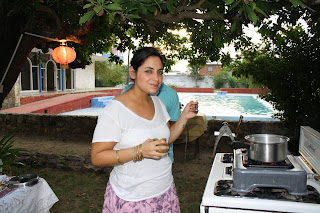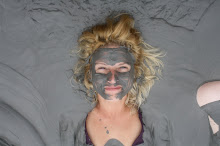On Saturday night there was a party in Prado Mar at a colleague’s house. It was in a huge garden with a DJ then a live band, but that is not what this story is about. A teacher named Fatima had invited me to the party. When I arrived, she introduced me to her step-mom who lived across the street and told me on Monday that she would be having cooking classes there. That sounded perfect to me.
I first met Fatima at the beginning of the school year during one of the many day-long inservices. She arrived late wearing sparkly jewelry and blue stockings. The director introduced her as the art teacher. I knew immediately that we would end up being friends. I found out later that she had lived with her mom in Chicago and gone to the Chicago Art Institute. We ended up having a little art talk, as I’d taken an amazing class there way back in high school, and then majored in art in college. As time went on, I learned that her mom was Pakistani and that Fatima had spent her teenage years in Pakistan. The cooking classes were on how to prepare Pakistani, not Colombian cuisine.
Right after school on both Monday and Tuesday I attended Fatima’s Pakistani cooking classes in the enormous garden of her step-mom’s house. The table was set with an array of colorful and aromatic spices: cayenne pepper, garam masala, tumeric, cloves, cardamom pods, peppercorns, and cinnamon sticks. This was set on an Indian print tablecloth, under a nispero tree, with a swimming pool in the distance, and a stove set up outside. All the while the tabla beat of Bhangra music was softly playing in the background.
All the other attendees were Colombian, so the classes were taught in Spanish about Pakistani food and culture. Una buena mezcla. Fatima speaks excellent English (as well as Urdu, some Punjabi, and Hindi), and was able to tell me words in English when I didn’t know what she meant in Spanish, which, thankfully, was not very often.
The menu was to please all the tastes: sweet, sour, bitter, and salty, so that we left feeling completely satisfied. Since food is an international language, I will translate the menu from Spanish into English, but leave the Pakistani names as they are.
Menu Day 1
Garbanzo salad with cilantro and ginger
Potato cutlets with a yogurt and mint chutney
Spiced basmati rice with peas
Dahi Murgh (Chicken in a yogurt sauce)
Cardamom lassie
Menu Day 2
Pakistani chai spiced tea
Eggplant in yogurt sauce
Salmon with garam masala
Basmati rice with vegetables
Khir (rice with sweetened condensed milk)
Both menus were excellent and I definitely learned a few new cooking tips. For those keen observers, you may notice that chicken is on this list. Yes, it’s true, after more than 20 years of being pescetarian, since I’ve been in Colombia occasionally I have eaten chicken. (Dad, don’t fall out of your chair). I will try the smallest bite of anything, because I want to be open-minded and culturally sensitive. Beef still disgusts me in every form and I just can’t eat it, but have eaten chicken that has been rather tasty. It’s not like I’m going to start ordering chicken at restaurants, but if it’s being served I will eat a little bit. The sauce of the Dahi Murgh was succulent. I was thinking about making this dish with tofu or some type of fake meat when I prepare it.
Those of you who have heard the ingredients Colombia lacks may be wondering where she got what she needed to prepare the food. Well, she had to go to several stores and paid very high prices for items such as Basmati rice (a little bag cost $10 USD, and looked like something you could buy at Trader Joe’s in the US for about $1.79). As for the spices, they had been imported from India to the US, and she had bought them in Chicago.
Here is a complete cultural difference - many people have servants, maids, nannies, and even chauffeurs here. I don’t think it’s only the extremely wealthy, because when I have asked teachers where their children are (since this week kids weren’t in school and we still had to work) a lot of them have said, “They’re with the nanny.” During the cooking class there was a servant who helped Fatima with the preparation and serving.
Her step mom teaches yoga here. I will attend next week.
I did not have my camera the first day and don’t have pictures of the final plates because it was dark by the time we ate.
After class, my friend Yoyi picked me up on a motorbike. We rode through the streets of the town of Puerto Colombia where people were socializing everywhere. After riding near the malecón, we drove up the dirt roads amongst little houses, with children playing outside accompanied by a soundtrack of vallenato music. He took me to a cabaña overlooking the Caribbean where the full moon shone on the waves. It was incredibly peaceful in contrast to the busy-ness of Barranquilla.
The next day I also got to see Fatima’s cute apartment that had a fruit tree off the balcony, and a view of the sea. After seeing more of Prado Mar, I might need to reconsider moving there. After all, I am living so close to the Caribbean, it might be nice to actually be on the water instead of in an apartment building that could be anywhere in Colombia.
On the bus ride home I ended up sitting next an adorable little 4 year-old girl whose father I’d met when I’d gone surfing. She was a rather loquacious child and we talked the entire way to Barranquilla.
This was more of what I had imagined my experience would be: spending time doing things I like with Colombian friends, and talking in Spanish. Ahora estoy mucho más feliz.







No comments:
Post a Comment